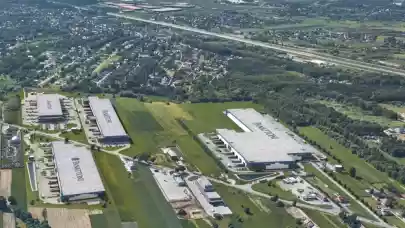
Retailers and landlords have to be aware that they’re always part of a local community, says Dr. Angelus Bernreuther, Head of Investor Relationship Management at Kaufland. He talked to Property Forum about his outlook for the retail market in CEE and also shared details of the company’s ESG strategy and expansion plans.
What is your outlook for the retail market in the CEE countries in which you operate going forward?
Kaufland runs more than 1,500 large supermarkets in Europe with a strong focus on Germany and the CEE countries. We have seen a lot of change in the retail industry over the last years.
We’ve all experienced changes in customer behaviour, but certainly, digitalization and sustainability, among others, are being identified as two of the main triggers for change.
Retail generally is back on track, especially in the CEE countries. Despite all challenges, footfall has returned to retail locations.
Kaufland has been expanding since 2020, also during the pandemic, opening more than 150 stores in Europe. We are still seeing substantial growth in all of our operating countries.
Relevance in customers’ mindset, therefore, plays a decisive role. The role of an anchor perhaps matters more than ever. As a food retailer, it is more than buying food. It is about being a focus point for the customer, which is integrated into their lives. Kaufland recently opened its 1,500th store in Romania. The customer promise for every big supermarket is to be the main footfall anchor on site: from rural to metropolitan areas, from smaller towns to district centres, we offer a relevant and large choice of on average 30,000 items adapted to the local needs at very competitive prices.
Is inflation playing a significant role in your customers' purchasing decisions?
Inflation definitely was one of the major challenges to our economies in general and something our customers, in particular, had to deal with in the last months. This has of course a direct impact on consumer spending. One of the key drivers in light of the current war in Ukraine was certainly the energy sector. But it shouldn’t be forgotten that food has faced rising prices too, which are luckily about to fall again. Kaufland, as a large supermarket, offers an average range of 30,000 items per store. A variety from discount to organic items, from private to industry labels is a key proposition towards our customers. This enables us to offer the choice customers need according to their spending possibilities. In times of inflation too, Kaufland’s attitude remains more than ever to provide the best prices possible.
How is innovation shaping Kaufland’s operation of its big supermarkets in Europe and what does it mean for your future investments?
On the one hand, we operate in a very competitive environment. On the other hand, our customers are constantly adapting their behaviour, given the new conditions and trends, e.g. with regard to sustainability and digitalization. Keeping our concept up-to-date and constantly integrating innovation into our daily business was key for future success. This concerns all departments in our company, from purchasing, sales, and logistics to real estate.
How are you integrating digital platforms into your network of physical hypermarkets?
As already mentioned, innovation constantly shapes our operations. The impact of digitalization is a good example of this. To create vibrant brick-and-mortar locations, that is the aim of course. But don’t neglect digitalization. It does not necessarily mean implementing an online sales channel. Digitalization is more than online trade. It is the entire customer journey, and this definitely is 24/7 across many channels. For locations and retailers, visibility both online and offline towards customers is key in the digitalization age. Some examples to underline this: influencer marketing in B2C connects more relevant people with the Kaufland brand. We introduced our loyalty program “Kaufland Card” in all of our country markets to achieve an even more targeted connection with the local community. Just a few months ago, we launched the trading platform kaufland.cz in the Czech Republic, our third online marketplace after Germany and Slovakia to complement a non-food assortment in more than 5,000 categories online to our physical food experience. Brand and location-based customer touchpoints online and offline are key for future success. We recently opened a showroom concept to test this interaction in practice in one of our German stores. The aim is to inform the customer offline about our tremendous offers online, ideally to create an overall omnichannel experience that bounces back directly with a visit to our supermarkets and vice-versa.
Which are the main factors that enhance the customer experience in Kaufland’s hypermarkets?
Shopping locations were often planned with a focus on functionality. To some extent, it has to be like this, of course, being an operator property. But within the trend towards more urbanity and ambience, retailers and landlords have to be aware, that they’re always part of a local community. Ideally, as one of the crystallization points in the neighbourhood. This is always related to the local conditions and structures and can involve adapting the retailers’ business operations. Just to give an example from our everyday work. We adapt our assortment to the local demographics, try to source locally and regionally whenever possible, showcase our local producers at events like the “Regional Days”, and add concept value through our local tenant partners such as bakeries and cafés for a better overall shopping experience and engage with the local community such as by cooperations with schools, art projects or similar initiatives.
Are you looking to add more Kaufland hypermarkets in mixed-use schemes?
Kaufland operates large supermarket formats from Poland, Czech Republic, Romania, Slovakia to Croatia, Bulgaria, Moldova and Germany, but always with an eye on the local conditions. We have an understanding of being a footfall anchor for all retail locations, from stand-alone supermarkets, retail parks and shopping centres to inner-city locations. We always strive to find common solutions for existing or new buildings. Flexibility in the construction and operation of our real estate has always been a matter of course for us: whether our stores are at ground level, elevated or with underground parking solutions. In this context, we are certainly open to complementary, mixed-use development. Whether office, hotel or residential. We, therefore, focus on general catchment areas with more than 25,000 inhabitants, towns with at least 10,000 inhabitants and minimum sales areas from 2,000 to 2,500 sqm upwards in rural as well as metropolitan areas.
What are some of your ongoing objectives in the ESG field? What do your customers expect from your sustainability agenda?
Sustainability has reached the public and economic discussion not only as a nice-to-have topic, but a must-do necessity. This draws attention to how stores and locations are presented and operated. Implicitly, because the customer values more sustainable products and services, which is a competitive advantage when you meet their needs within the tenant mix and product range. Explicitly, when a sustainable shopping ambience has a positive impact on the customer’s shopping mood. Modern LED lighting not only saves energy but also leads to more relaxed shopping conditions in the sales area. Natural building materials like timber create an even more pleasant shopping experience. And in general: Revitalized locations with an existing network within the catchment area are often more accepted over new schemes without a local “soul”.



